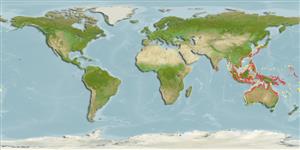Common names from other countries
Classification / Names / Names
ชื่อสามัญ | ชื่อพ้อง | Catalog of Fishes (gen., sp.) | ITIS | CoL | WoRMS
Environment: milieu / climate zone / depth range / distribution range
นิเวศวิทยา
; กร่อย. Tropical
Indo-West Pacific: from India to Vanuatu; north to southern islands of Japan, and south to Queensland and New Caledonia.
Length at first maturity / ขนาด / น้ำหนัก / Age
Maturity: Lm ? range ? - ? cm Max length : 10.5 cm SHL เพศผู้/กระเทย; (Ref. 348); common length : 7.0 cm SHL เพศผู้/กระเทย; (Ref. 348)
Widely collected as food in Asia (Ref. 348). Found in intertidal areas in mangrove mud (Ref. 75831, 85174). Also in fresh and brackish waters of mangrove swamps, estuaries, and larger rivers. Highly tolerant to surface desiccation of its habitat; can survive by aerial respiration at the posterior mantle margin for a period of a few days, and feed from subterranean water by means of water exchange through a narrow anterior gape of valves (Ref. 345).
Life cycle and mating behavior
วัยเจริญพันธุ์ | การสืบพันธุ์ | การวางไข่ | เซลสืบพันธ์ของเพศเมีย(ไข่) | ความดกของไข่ | ตัวอ่อน
Members of the class Bivalvia are mostly gonochoric, some are protandric hermaphrodites. Life cycle: Embryos develop into free-swimming trocophore larvae, succeeded by the bivalve veliger, resembling a miniature clam.
Poutiers, J.M. 1998. (Ref. 348)
IUCN Red List Status (Ref. 130435)
CITES status (Ref. 108899)
Not Evaluated
Not Evaluated
Threat to humans
Harmless
Human uses
| FishSource |
เครื่องมือ
แหล่งที่มาจากอินเตอร์เน็ต
Estimates based on models
ความสามารถในการกลับคืนสู่ปกติ
ความสูง, เวลาต่ำสุดที่จะทำให้ประชากรเพิ่มขึ้นเป็น 2 เท่าใช้เวลาน้อยกว่า 15 เดือน (K=0.76).
Vulnerability
Low vulnerability (10 of 100).
Price category
Unknown.
